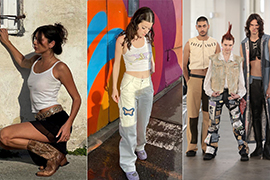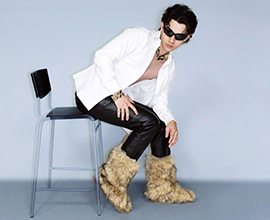- Slug: BC-CNS-Post-pandemic Fashion,760 words.
- 2 photos available (thumbnails, captions below).
By Karina Romero
Cronkite News
LOS ANGELES – Whether binge-watching “Tiger King,” attempting a new TikTok dance or scavenging for toilet paper, consumers outlasted the coronavirus quarantines. But all manner of fashion was put on hold.
Today, the rebound from life in the COVID-19 bunker has become a renaissance of personal style and self-expression.
Fashionistas have shed their pandemic sweatpants and hoodies. In returning to society, they have embraced chic colors like lavender, sunshine yellow and trendy cool-toned pink. They have ditched elaborate prints like plaid and paisley while adding rocking details like tassels, ruffles and lace to their wardrobe.
Women are wearing dresses with daring cutouts and sporting black leather boots. Others are going back to basics and stocking their closets with wardrobe staples. Think of the little black dress, the white blouse or blue jeans.
For many, experts say the pandemic brought about a fashion reset, a move from over-the-top looks to greater sophistication.
“I’ve seen so many designers and brands come out of it,” said Gabriela Roselen, a New York City-based fashion designer, about the pandemic blahs. “It’s like beautiful flowers grew from a weeded garden.”
One legacy of pandemic living: More people are now getting fashion inspiration from TikTok.
“When I think back to quarantine, what first comes to mind is TikTok. So much more of my time was spent there, and I started getting increasingly interested in fashion,” said Rachel G. Wilson, an LA-based Instagram lifestyle influencer. “At first, I wore many trendy pieces that were super popular. As time went on, I started to get a better idea of what I liked about myself.”
Others have noticed that trend toward personalization.
“Everyone now has their form of identity,” said Shifteh Shahbazian, a wardrobe stylist and fashion show production expert. “Before the pandemic, you would go out and about in Los Angeles and see excessive makeup or intense outfits. But after, it felt like everyone was listening to their inner soul.”
The return of early-2000s fashion was a trend few could have expected. As people dug into their closets during quarantine, they emerged with Y2K-era icons such as baguette-style handbags, velour tracksuits and Ugg boots. But the nostalgia trend didn’t stop at Y2K. The fashion scene has seen the return of feminine ballet-inspired apparel like frilly dresses and ballet slippers or other genres like the macabre Goth look.
“Since the beginning of time, fashion history has repeated itself. We would have eventually seen the return of these styles, but the pandemic helped speed up the process. The nostalgic feel of old trends comforted us during a chaotic and unknowing time,” Shahbazian said.
The pandemic also launched fashion careers.
Steven Sweet Ruth, a 20-year-old fashion student at the Fashion Institute of Design & Merchandising in Los Angeles, has turned a sewing hobby into a career.
“In 2019, I stopped fighting my identity and came out to my family as nonbinary. It allowed me to play with clothes and try androgynous styles. But when the pandemic hit, I found my personal identity in fashion,” Ruth said. “I have refined my aesthetic and found my voice in the industry.”
Ruth is a part of the advanced study fashion design program and participated in the 2023 Debut Runway show as a designer. FIDM selects 12 students for the advanced program each year, where they are tasked to make their fashion line with over 16 articles of clothing.
Javier Berrellez discovered his passion for fashion during the COVID-19 pandemic. Berrellez transitioned from streetwear like cargo pants and Nike-branded T-shirts to more timeless pieces like cowboy boots and leather pants. Berrellez recently finished a journalism degree from the University of Arizona and hopes to begin his fashion career as a model in Los Angeles.
The COVID-19 pandemic gave many people a new sense of self.
Bianca Rodriguez hosts WhatNewYorkWears, a collaborative creative space on TikTok and YouTube that posts people’s day-to-day fashion in New York City.
“Before the pandemic, my style was very much tailored to what I thought would make me stand out, no matter the comfort or material structure. But post-pandemic, I love to play with slouchy and comfortable clothing and dress it up in what feels most me,” she said.
For fashion designer Roselen, the COVID-19 pandemic was the push she needed in the right direction. During quarantine, Roselen began to design her custom denim line, which will launch this summer. Roselen is a part of Spicie, a New York brand that focuses on futuristic crochet designs.
For her, the quarantines presented an opportunity for change.
“After the pandemic, everything started coming full circle,” she said.
For more stories from Cronkite News, visit cronkitenews.azpbs.org.
^__=
From left, Rachel G. Wilson models wardrobe staples from her closet: a white tank top, black skirt and cowgirl boots; Gabriela Roselen in white denim pants with a purple butterfly detail from her line launching this summer; Steven Sweet Ruth, who turned sewing talent into a career in fashion design, is flanked by in clothes from the line. (Photos courtesy Wilson, Roselen and Ruth)
Javier Berrellez models for VITALY, an accessory design shop. (Photo courtesy of Javier Berrellez)

